Life without the Moon: a scientific speculation Understand article
Soaring temperatures, a flooded landscape, violent winds…. What would our planet be like without the Moon?
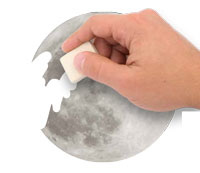
Tranfield / Goloverez /
iStockphoto
The Moon, der Mond, la lune. Its name and even its gender vary from language to language but there is no question that it is key to our image of Earth. Can you imagine Earth without a moon? No beautiful, bright object traversing the night sky, hovering on the horizon, peeking through the trees on a cold winter’s night? No romantic moonlight, no Blue Moon, and no lunar landings. Not only would we miss it – without the Moon, we might not even exist.
Let us imagine two scenarios: (i) if Earth had never had a moon and (ii) if our moon suddenly vanished. But first, let’s remind ourselves of the Moon’s effects on Earth.
Time and tides: the Moon’s influence on Earth
Earth did not always have a moon, so where did it come from? The leading scientific theory is that an object about the size of Mars, called Theia, collided with Earth about 4.5 billion years ago. Striking at an oblique angle, it raised a cloud of debris that then coalesced to form the Moon. This had profound effects on Earth.
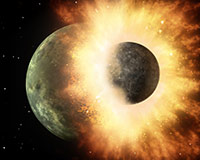
formed in a high-speed
impact, when a body the size
of Mars slammed into the
young Earth about 4.5 billion
years ago. The resulting
molten rock, vapour and
shattered debris mixed with
debris from Earth to form a
ring around our planet. Over
time, this debris coalesced to
make the Moon.
Image courtesy of NASA /
JPL-Caltech
Earth and its newly formed moon exerted a gravitational force on each other, slowing the rotation of Earth and lengthening the Earth day from 5 hours to 24 (Touma & Wisdom, 1998). In fact, to this day, the Moon continues to slow down the rotation of Earth, although only by 0.002 seconds per century (figure 1).
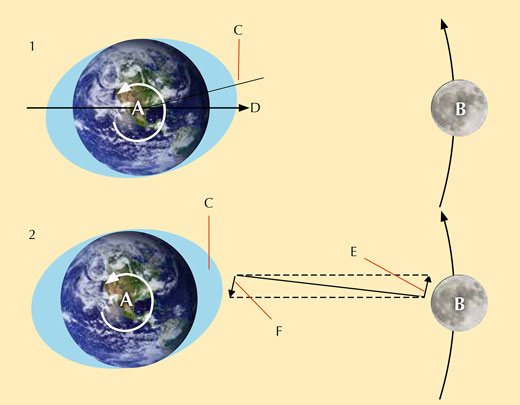
1) Earth rotates faster than the Moon orbits Earth, causing friction as the land rotates under the tidal bulge. The friction between land and the tidal bulge pulls the tidal bulge forward (C) so that it is ahead of the line of attraction between Earth and the Moon (D).
2) The friction force (F) between Earth and the ocean acts as a brake. This force is called tidal braking and it ‘pulls’ Earth backwards in its orbit, effectively slowing the rotation of Earth. Tidal braking also affects the Moon through force (E), which ‘pulls’ the Moon forward in its orbit, effectively speeding up the rotation of the Moon. This is what causes the orbit of the Moon to slowly increase, causing it to slowly move further from Earth. Click on image to enlarge.
Image courtesy of Nicola Graf
The gravitational attraction between Earth and the Moon also stabilised the tilt of Earth’s axis, and it is today’s constant tilt of 23.5° that gives Earth its predictable, fairly constant climate and its seasons (figure 2). Without the Moon, however, the axis would have continued to wobble.
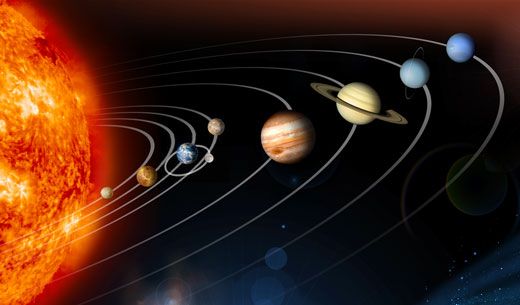
Image courtesy of NASA / JPL
Another feature of our planet is its oceans: more than 70% of Earth’s surface is covered by salt water, rising and falling on a 12.5 h tidal cycle. The forces that create tides are complex, involving not only the centrifugal forces of Earth’s rotation but also the gravitational pull of both the Moon and the Sun (figure 3). The effect of the Moon, however, is twice that of the Sun; this is because the gravitational force that one object exerts on another depends on both its mass and its distance.
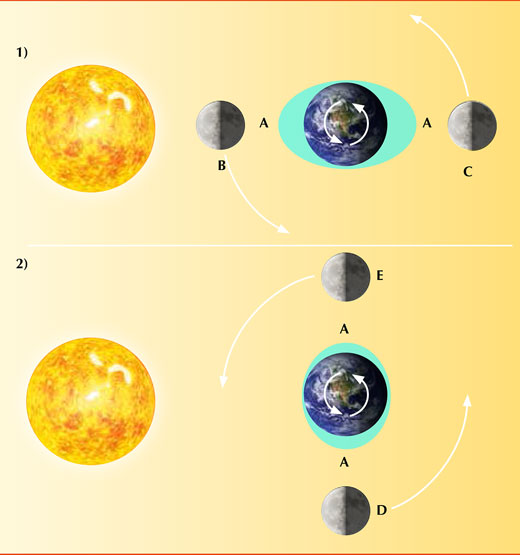
The tides also show a pattern linked to the lunar cycle. When the Moon and the Sun are aligned (at new moon, B, or full moon, C), their combined gravitation pull is strongest and the tides are highest (spring tides). When the Moon is in its first quarter (D) or third quarter (E), the tides are lowest (neap tides). Click on image to enlarge.
Image courtesy of Nicola Graf
We do not know how close the Moon was to Earth when it first formed, but we do know that it was farther than 12 000 km and closer than it is today (about 384 400 km). This means that it initially caused much larger tides than we experience today – tides that are thought to have been important in mixing the oceans and in the early evolution of life, some 3.8 billion years ago (Comins, 1996).
Interestingly, the tides and the rotation of Earth have an effect on the Moon. Together, they pull on the Moon, making it spin just a little faster, and as it spins faster and faster, it moves further away from Earth – albeit at a rate of only 3.82 cm per year (figure 1).
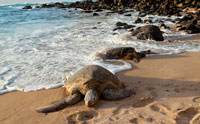
tend to lay their eggs at
spring tides, when the
highest high tides occur.
These tides allow the female
turtles to swim up the beach
to lay their eggs above the
high-water mark (where they
hatch best).
Image courtesy of Kubrak78 /
iStockphoto
Scenario 1: what if we had never had a moon?
What would have happened on Earth if, about 4.5 billion years ago, Theia had passed peacefully on its way without striking Earth and forming a moon? Well, life of some sort would probably exist on Earth, but humans almost certainly wouldn’t. Think of the very long course of evolution, the small changes, the minute adaptations that organisms make to their environment. It would only have taken small changes to Earth’s environment to have dramatically altered the course of evolution. I wouldn’t be writing this article – and you wouldn’t be reading it.
And if the Moon had never formed, Earth would be a very, very different place. An Earth day would be only 8-10 h long, with no moon to slow it down. The faster rotation would cause winds of 160-200 km to sweep Earth’s surface. The tilt axis of Earth would wobble, resulting in dramatic changes in temperature over thousands to millions of years. And although our seas would still be tidal, the tides would be much smaller – caused only by the Sun.
You might like to ask your students to speculate about what kinds of life might have evolved on moonless Earth, capable of withstanding extreme temperatures, high winds, small tides and short days.
Scenario 2: what if our Moon suddenly vanished?

other groups of marine and
freshwater zooplankton
move up and down the water
column according to a daily
rhythm. If the Moon were to
disappear, Earth days would
become shorter and the
animals would need to
adapt to the shorter daily
rhythm.
Image courtesy of Nicolas
Hoizey / Flickr
Supposing the Moon just vanished tomorrow? We and all other organisms on Earth would be in serious trouble: we have evolved to live under a particular set of conditions and would then be faced with an entirely different environment. These changes would happen over the course of thousands to millions of years, which may sound like a long time, but the changes would be dramatic.
Without the Moon, the stability of Earth’s axis would be lost again, and with it, our predictable temperatures. Let us consider two cities: Rome, Italy, and Stockholm, Sweden. In summer the average high temperature in Rome is 29 °C, and in the winter the average high temperature is 13 °C. In Stockholm, the high in summer is 20 °C and in winter it is 0 °Cw1. If Earth’s tilt axis changed, the temperatures in these two cities would change dramatically. Imagine if the temperatures were swapped: the infrastructure (e.g. air conditioning or snow ploughs) would simply not be in place in those cities for humans to live, work and eat comfortably. The Italians, Swedes and all other life on Earth would need to adapt or face extinction.
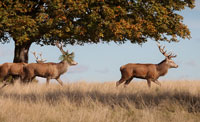
deer, mate at specific times
of year. What effect might the
loss of the Moon – and of our
seasons – have on these
organisms?
Image courtesy of Alex
Groundwater / Flickr
Moving might be one option, but not for all organisms. Coral reefs, for example, are sensitive and complex ecosystems that might not be able to adapt fast enough to the changing water temperature and would probably die (Saxby et al., 2003).
Furthermore, as the temperatures changed, Earth would lose its reliably cold regions: the poles, which contain huge amounts of ice. This ice would melt and the oceans would rise, changing the coastlines all around the world. Countries like the Netherlands would be covered in water.
With the lack of stability in Earth’s tilt, we would also lose our regular seasons, with far-reaching consequences. Think how many organisms grow, mate, migrate or hibernate at particular times of year. And drastic changes in temperature would affect the growing season and climate for plants, making food production for the billions of people on Earth more complex.
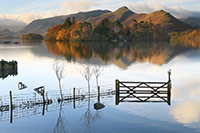
our regular seasons, how
would this affect deciduous
trees – which provide this
beautiful autumn colour in
the UK’s Lake District?
Image courtesy of
midlander1231 / Flickr
Nothing but lunacy?
You might not expect to find so much overt speculation in a science article. However, encouraging students to imagine a world without a moon is a fun exercise to illustrate all the interesting ways that the Moon makes Earth the wonderful planet we know. Such an exercise not only introduces some complex physics in a simple context, but also gives students an opportunity to think about the course of evolution, and the way in which every aspect of our lives is affected by our environment.
References
- Comins NF (1996) What if the Moon Didn’t Exist? San Francisco, CA, USA: Astronomical Society of the Pacific. www.astrosociety.org
- Saxby T, Dennison WC, Hoegh-Guldberg O (2003) Photosynthetic responses of the coral Montipora digitata to cold temperature stress. Marine Ecology Progress Series 248: 85-97.
- Touma J, Wisdom J (1998) Resonances in the early evolution of the Earth-Moon system. The Astronomical Journal 115(4): 1653-1663. doi: 10.1086/300312
Web References
- w1 – The World Weather and Climate Information website offers information about the weather and climate for almost every country around the world.
- w2 – The International Space University provides graduate-level training to the future leaders of the space community.
Resources
- Canup RM (2012) Forming a moon with an Earth-like composition via a giant impact. Science. doi: 10.1126/science.1226073
- Comins NF (1993) What if the Moon didn’t exist: voyages to Earths that might have been. Bloomington, IN, USA: iUniverse. ISBN: 9781475930948
- Foing B (2007) If we had no moon. Astrobiology Magazine. www.astrobio.net
- What if the Moon did not exist? podcast by Patrick McQuillan, on the 365 Days of Astronomy website.
Review
The Moon has always been present in our lives and most of us are not aware of its importance. Before reading this article, students could think about and discuss the Moon’s influence on Earth. The discussion could be carried out in small groups where all members have the opportunity to express their opinions.
Because the article provides information on the role of the Moon in the origin and evolution of life, it could also be used as an introduction to how evolution works. Students could then talk about the effect that human beings have on the environment.
Finally, the article also provides a context for teaching physical concepts, particularly the study of gravitational fields, thus helping to raise students’ interest in the topic.
The article could be used as a comprehension exercise, including questions such as:
- What is the origin of the Moon?
- What is the effect of the Moon on Earth?
- What was the role of the Moon in the origin and evolution of life on Earth?
- What would happen if the Moon suddenly vanished?
Mireia Guell Serra, Spain





